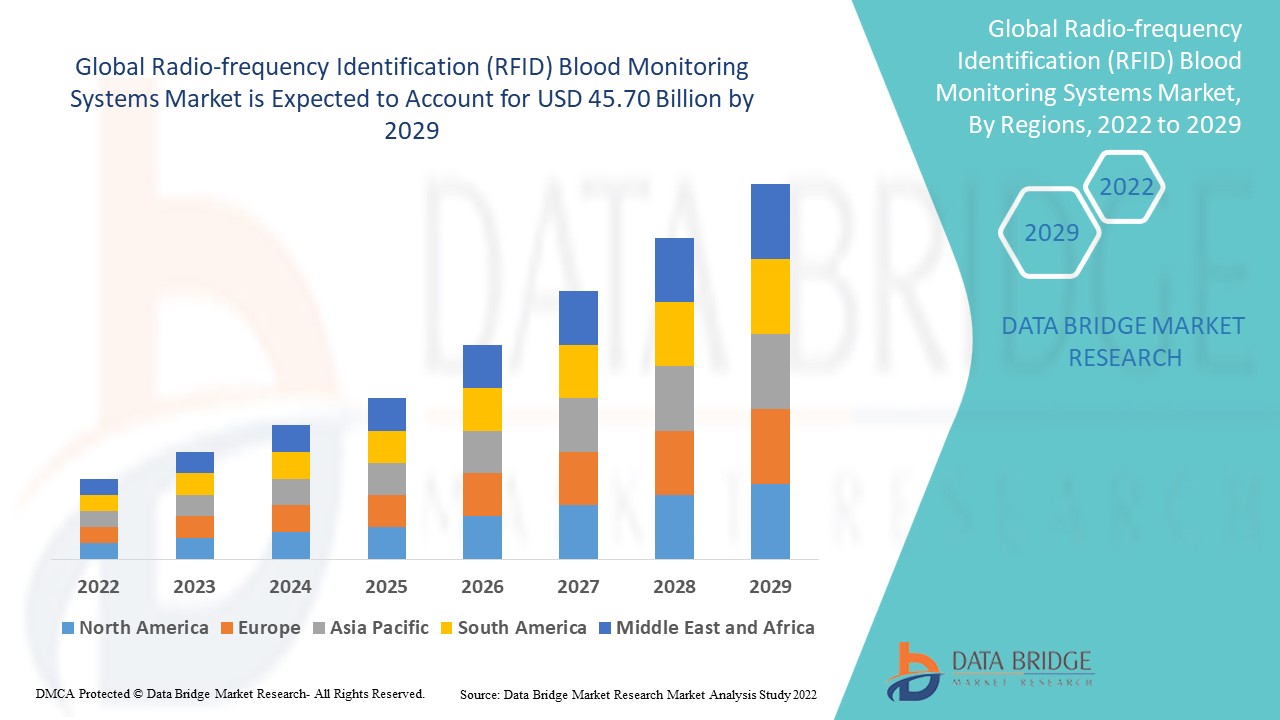Global Radio Frequency Identification Rfid Blood Monitoring Systems Market
市场规模(十亿美元)
CAGR :
% 
 USD
10.70 Billion
USD
45.70 Billion
2021
2029
USD
10.70 Billion
USD
45.70 Billion
2021
2029
| 2022 –2029 | |
| USD 10.70 Billion | |
| USD 45.70 Billion | |
|
|
|
>全球射频识别 (RFID) 血液监测系统市场,按产品(系统和标签)、应用(资产跟踪、患者跟踪、药品跟踪、血液跟踪等)、最终用户(血库、医院血液中心)划分 - 行业趋势和预测至 2029 年

射频识别 (RFID) 血液监测系统市场分析和规模
RFID 血液监测系统在近期得到广泛应用,预计在预测期内将大幅增长。在其他细分市场中,RFID 市场的标签细分市场预计在预测期内将以更高的复合年增长率增长。标签是 RFID 市场中使用最广泛的组件。标签的大规模使用和追踪任何资产的可行性是采用 RFID 标签的主要原因。
Data Bridge Market Research 分析了 2022-2029 年预测期内射频识别 (RFID) 血液监测系统市场的增长情况。在上述预测期内,全球射频识别 (RFID) 血液监测系统市场的预期复合年增长率约为 19.90%。2021 年市场价值为 107 亿美元,到 2029 年将增长至 457 亿美元。除了市场价值、增长率、细分市场、地理覆盖范围、市场参与者和市场情景等市场洞察外,Data Bridge Market Research 团队策划的市场报告还包括深入的专家分析、患者流行病学、渠道分析、定价分析和监管框架。
射频识别 (RFID) 血液监测系统市场范围和细分
|
报告指标 |
细节 |
|
预测期 |
2022 至 2029 年 |
|
基准年 |
2021 |
|
历史岁月 |
2020(可定制为 2014 - 2019) |
|
定量单位 |
收入(百万美元)、销量(单位)、定价(美元) |
|
涵盖的领域 |
按产品(系统和标签)、应用程序(资产跟踪、患者跟踪、药品跟踪、血液跟踪等)、最终用户(血库、医院血液中心) |
|
覆盖国家 |
北美洲的美国、加拿大和墨西哥、欧洲的德国、法国、英国、荷兰、瑞士、比利时、俄罗斯、意大利、西班牙、土耳其、欧洲其他地区、亚太地区 (APAC) 的中国、日本、印度、韩国、新加坡、马来西亚、澳大利亚、泰国、印度尼西亚、菲律宾、亚太地区 (APAC) 的其他地区、沙特阿拉伯、阿联酋、南非、埃及、以色列、中东和非洲 (MEA) 的其他地区、巴西、阿根廷和南美洲的其他地区。 |
|
涵盖的市场参与者 |
Biolog-id(法国)、Terso GmbH(德国)、Nordic ID Oyj(芬兰)、SATO Holdings Corporation(日本)、Cardinal Health(美国)、Medtronic(爱尔兰)、Abbott(美国)、F. Hoffmann-La Roche Ltd(瑞士)、Johnson & Johnson Private Limited(美国)、B. Braun Melsungen AG(德国)、BD(美国) |
|
市场机会 |
|
市场定义
RFID 在无线电频率上为特殊标签和可检测标签的读取器设备之间提供了通信基础设施。它还允许在系统内的设备之间建立桥梁,而无需任何物理接触,甚至有时彼此看不到。该技术也广泛应用于医疗保健领域。该系统支持 RFID 标签和读取器之间的无线蜂窝通信。系统中的每个患者本质上都是移动的,并佩戴带有独特标签的手镯。读取器是移动 PDA 设备;每个都涉及无线 RFID 读取器卡。它可用于识别和持续观察患者。
全球射频识别 (RFID) 血液监测系统市场动态
驱动程序
- 科技进步
预计在预测期内推动全球 RFID 血液监测市场扩张的另一个因素是 RFID 系统的技术进步,特别是基于微纳米技术并可存储大量数据的 RFID 标签。此外,全球市场的一个突出的新兴趋势是全球发达经济体和发展中经济体的血库和医院越来越多地实施 RFID 血液监测系统,预计这将在预测期内推动全球市场增长。
- 优越的性能
RFID 血液监测系统与传统的血液跟踪和监测方法相比具有诸多优势,例如条形码可以越来越快地扫描和记录血液样本。此外,所采用的测试协议可以评估 RFID 设备在血液供应链过程中的效率,因为它的制造是为了模拟关键的物流过程。
机会
- 血库需求增加
由于全球血库广泛采用 RFID 血液监测系统,预计血库在预测期内的复合年增长率最高。此外,血库中射频识别系统的使用率不断提高,有望提高运营效率、降低成本并提高患者安全性,这也是预测期内推动市场增长的主要驱动因素之一。
- 由于 COVID-19,接触者追踪解决方案的需求不断增加
在解除 COVID-19 疫情封锁后,全球许多企业和办公室得以恢复运营。另一方面,政府要求这些企业保持社交距离和最低限度的劳动力。如果不遵守规定,一次 COVID-19 疫情就可能导致整个工厂停工,并需要进行净化才能恢复运营。大型企业正在实施各种预防措施,包括接触者追踪系统。在 COVID-19 疫情期间,许多 RFID 解决方案供应商一直在开发新产品或改进现有产品以满足客户的需求,以利用对接触者追踪解决方案日益增长的需求。
限制/挑战
- 安全问题
RFID 系统的安全问题、数据隐私问题和管理挑战都是预测期内阻碍射频识别 (RFID) 血液监测市场增长的主要因素。在构建 RFID 系统以确保基本安全级别时,许多方面都被忽略了。此外,由于在各种环境中可能共存的多种攻击和威胁来源,维护一个完全安全的系统(即保持整个系统安全和运行)是一项艰巨的任务。
- 缺乏意识和熟练的专业人员
目前,终端用户对 RFID 技术的认知度相对较低。终端用户仍在使用传统的识别程序(如字母数字标签、编号或条形码)手动跟踪资产。许多终端用户认为 RFID 技术价格昂贵,因为他们不了解其长期效益。许多亚洲国家/地区广泛使用传统资产跟踪。客户对 RFID 技术缺乏了解和能力,因此无法在其业务中利用 RFID 的潜在效益。这些变量成为采用 RFID 解决方案的障碍。
本射频识别 (RFID) 血液监测系统市场 报告详细介绍了最新发展、贸易法规、进出口分析、生产分析、价值链优化、市场份额、国内和本地市场参与者的影响,分析了新兴收入领域的机会、市场法规的变化、战略市场增长分析、市场规模、类别市场增长、应用领域和主导地位、产品批准、产品发布、地理扩展、市场技术创新。如需了解有关射频识别 (RFID) 血液监测系统市场的更多信息,请联系 Data Bridge Market Research 获取分析师简报,我们的团队将帮助您做出明智的市场决策,实现市场增长。
COVID-19 对全球射频识别 (RFID) 血液监测系统市场的影响
COVID-19 造成了前所未有的全球公共卫生危机,几乎影响了所有企业,其长期影响预计将在预测期内影响行业增长。我们正在进行的研究正在增强我们的研究方法,以确保涵盖 COVID-19 的基本问题和潜在解决方案。
COVID-19 不仅对各 RFID 公司的运营产生了巨大影响,还影响了其合作伙伴和分销商的业务。封锁措施导致全球对昂贵零售产品的需求下降,加上供应链中断,预计将减缓 RFID 市场的增长。全球汽车需求下降预计也将对汽车 RFID 市场产生中期影响。尽管发展中国家的政府已要求在收费车辆上贴上 RFID 标签,但目前旅行限制限制了 RFID 标签的部署。在后疫情时代,汽车和消费电子等多个行业的制造工厂重新开业。尽管如此,由于社交距离规范不完善,欧洲等一些地区的工厂尚未恢复到 COVID-19 之前的水平。
全球射频识别 (RFID) 血液监测系统市场范围
射频识别 (RFID) 血液监测系统市场 根据产品、应用和最终用户进行细分。这些细分市场之间的增长情况将帮助您分析行业中增长缓慢的细分市场,并为用户提供有价值的市场概览和市场洞察,帮助他们做出战略决策,确定核心市场应用。
产品
- 系统
- 标签
应用
- 资产追踪
- 患者追踪
- 药品追踪
- 血迹追踪
- 其他的
最终用户
- 医院血液中心
- 血库
射频识别 (RFID) 血液监测系统市场区域分析/见解
对射频识别 (RFID) 血液监测系统市场 进行了分析,并按国家、产品、应用和最终用户提供了市场规模洞察和趋势。
射频识别(RFID)血液监测系统市场报告涉及的主要国家 有:北美的美国、加拿大和墨西哥、欧洲的德国、法国、英国、荷兰、瑞士、比利时、俄罗斯、意大利、西班牙、土耳其、欧洲其他地区、亚太地区(APAC)的中国、日本、印度、韩国、新加坡、马来西亚、澳大利亚、泰国、印度尼西亚、菲律宾、亚太地区(APAC)的其他地区、中东和非洲(MEA)的其他地区、南美洲的巴西、阿根廷和南美洲其他地区。
北美凭借其发达的血库基础设施和对医院库存管理系统的高需求,在射频识别 (RFID) 血液监测系统市场占据主导地位。
由于 RFID 血液监测系统的普及率不断提高和医疗保健基础设施不断改善,预计亚太地区将在 2022 年至 2029 年的预测期内实现最快的增长率。
报告的国家部分还提供了影响市场当前和未来趋势的各个市场影响因素和国内市场监管变化。此外,在提供国家数据预测分析时,还考虑了全球品牌的存在和可用性以及它们因来自本地和国内品牌的激烈竞争或稀缺竞争而面临的挑战、国内关税和贸易路线的影响。
竞争格局和全球射频识别 (RFID) 血液监测系统市场份额分析
射频识别 (RFID) 血液监测系统市场竞争格局按竞争对手提供详细信息。详细信息包括公司概况、公司财务状况、产生的收入、市场潜力、研发投资、新市场计划、全球影响力、生产基地和设施、生产能力、公司优势和劣势、产品发布、产品宽度和广度、应用主导地位。以上提供的数据点仅与公司对射频识别 (RFID) 血液监测系统市场的关注有关。
全球射频识别 (RFID) 血液监测系统市场的主要参与者包括:
- Solaire Medical(法国)
- Techpoint(美国)
- Mobile Aspects Inc.(美国)
- 艾利丹尼森(美国)
- Zebra Technologies Corp(美国)
- 霍尼韦尔 (美国)
- 恩智浦半导体(荷兰)
- Impinj Inc(美国)
SKU-
Get online access to the report on the World's First Market Intelligence Cloud
- Interactive Data Analysis Dashboard
- Company Analysis Dashboard for high growth potential opportunities
- Research Analyst Access for customization & queries
- Competitor Analysis with Interactive dashboard
- Latest News, Updates & Trend analysis
- Harness the Power of Benchmark Analysis for Comprehensive Competitor Tracking
研究方法
数据收集和基准年分析是使用具有大样本量的数据收集模块完成的。该阶段包括通过各种来源和策略获取市场信息或相关数据。它包括提前检查和规划从过去获得的所有数据。它同样包括检查不同信息源中出现的信息不一致。使用市场统计和连贯模型分析和估计市场数据。此外,市场份额分析和关键趋势分析是市场报告中的主要成功因素。要了解更多信息,请请求分析师致电或下拉您的询问。
DBMR 研究团队使用的关键研究方法是数据三角测量,其中包括数据挖掘、数据变量对市场影响的分析和主要(行业专家)验证。数据模型包括供应商定位网格、市场时间线分析、市场概览和指南、公司定位网格、专利分析、定价分析、公司市场份额分析、测量标准、全球与区域和供应商份额分析。要了解有关研究方法的更多信息,请向我们的行业专家咨询。
可定制
Data Bridge Market Research 是高级形成性研究领域的领导者。我们为向现有和新客户提供符合其目标的数据和分析而感到自豪。报告可定制,包括目标品牌的价格趋势分析、了解其他国家的市场(索取国家列表)、临床试验结果数据、文献综述、翻新市场和产品基础分析。目标竞争对手的市场分析可以从基于技术的分析到市场组合策略进行分析。我们可以按照您所需的格式和数据样式添加您需要的任意数量的竞争对手数据。我们的分析师团队还可以为您提供原始 Excel 文件数据透视表(事实手册)中的数据,或者可以帮助您根据报告中的数据集创建演示文稿。














